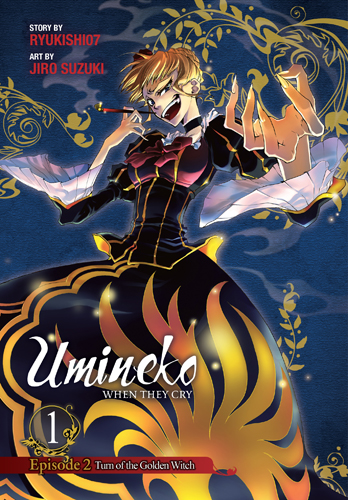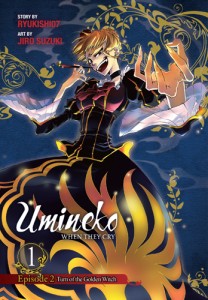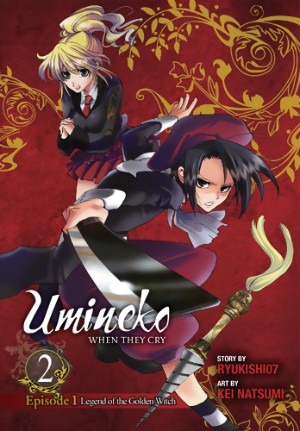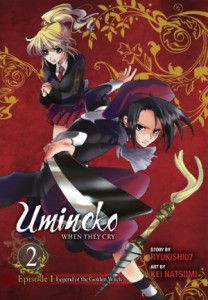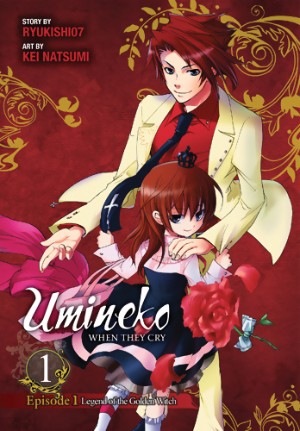Story by Ryukishi07; Art by Jiro Suzuki. Released in Japan in two and 1/2 separate volumes as “Umineko no Naku Koro ni: Turn of the Golden Witch” by Square Enix, serialized in the magazine GFantasy. Released in North America by Yen Press.
(In case there are any Umineko obsessives reading this, please avoid any future spoilers in comments. No need to Yasu this up till we have to.)
We’ve had our first go-round, and now Umineko begins its second arc. Surprisingly, for most of this volume Battler isn’t the protagonist, either. I was expecting, as with Higurashi, a few arcs that are simply “Battler is dumb” before things really got going. Here, though, we get a wider view of the cast. The fist half of this has the servants Shannon and Kanon as the dual protagonists, showing Shannon’s love for George and how she got a chance to make that love happen, as well as Kanon’s combination of jealousy and self-loathing that balance this out. Between the two of them, Beatrice has a lot to manipulate, and that’s exactly what she does here – though Shannon, at least, is starting to see through Beatrice’s motivations. Certainly more than Battler is.
The second half of the “island story” (more on the meta world later) focuses more on Maria and her mother Rosa, and oh dear I worry about the fandom just dropping this like a hot potato. Parental abuse is not unique to anime and manga, certainly, but it’s rare in a protagonist, and I think that’s what Ryukishi07 is trying to set Rosa up as here – particularly after the events of the first Twilight that remove the other potential adult protagonists. Her bipolar tendencies are simply hard to read, and we definitely see why Umineko fandom has sarcastically nicknamed her “BEST MOM EVER”. Maria’s not exactly helping her case, either – she’s just as hyper-annoying and creepy as she was in the first arc, and it’s easy to see (though not justify) why she would grate on every one of Rosa’s nerves. Basically, this is a horribly broken family, and putting them in a situation like this is just mean.
Which brings me to Battler and Beatrice. No, not the Battler who’s on the island, or the Beatrice who’s showing up doing magic things and dressing in stockings and short skirts; I’m talking about the Beatrice and Battler from the first arc, who are sitting over a gameboard watching as Battler tries to prove that the murders are human-caused, and Beatrice tries to prove they’re all due to magic. The arcs certainly tie together more than they do with Higurashi, and even more than that series, this one rewards re-reads – and is harsh to those who don’t pay attention. I have to say that I think Beatrice’s ‘move’ here is excellent – Battler could easily deny witches in the first arc when she was just portraits and butterflies, but now Beatrice is everywhere, flouting Battler by simply existing and doing supposed magic.
No one really reads this to identify with or bond over the characters, I hope – leaving aside the fact that they always die, these folks are simply far more unlikeable and broken than even Higurashi’s broken cast, and they’re explicitly compared to “game pieces”. No, we read this to try to figure out what’s actually happening here – particularly now that we have multiple realities stacking up with the ‘meta’ gameboard. I’m pretty sure that this arc isn’t going to give us any answers – in fact, as with Higurashi, I’m not expecting anything concrete till at least the 5th arc – but it does have a lot of pointing and shouting, and over the top faces (sometimes too over the top – I think the artists overdo it in Umineko based on the fan reaction to Higurashi’s faces), and grand guignol horror.
A manga that requires you to think about everything that’s happening, while also trying not to overthink things, seems very contradictory. But that’s Umineko in a nutshell, and if you don’t mind horrible things happening to horrible people, it’s still a great deal of fun. Especially now that Beatrice, who is pure evil on a stick, has made her grand debut.
(By the way, for those curious, Yen didn’t leave out any extras – the 2nd volume in Japan also lacked the extras Vol. 1 had.)
